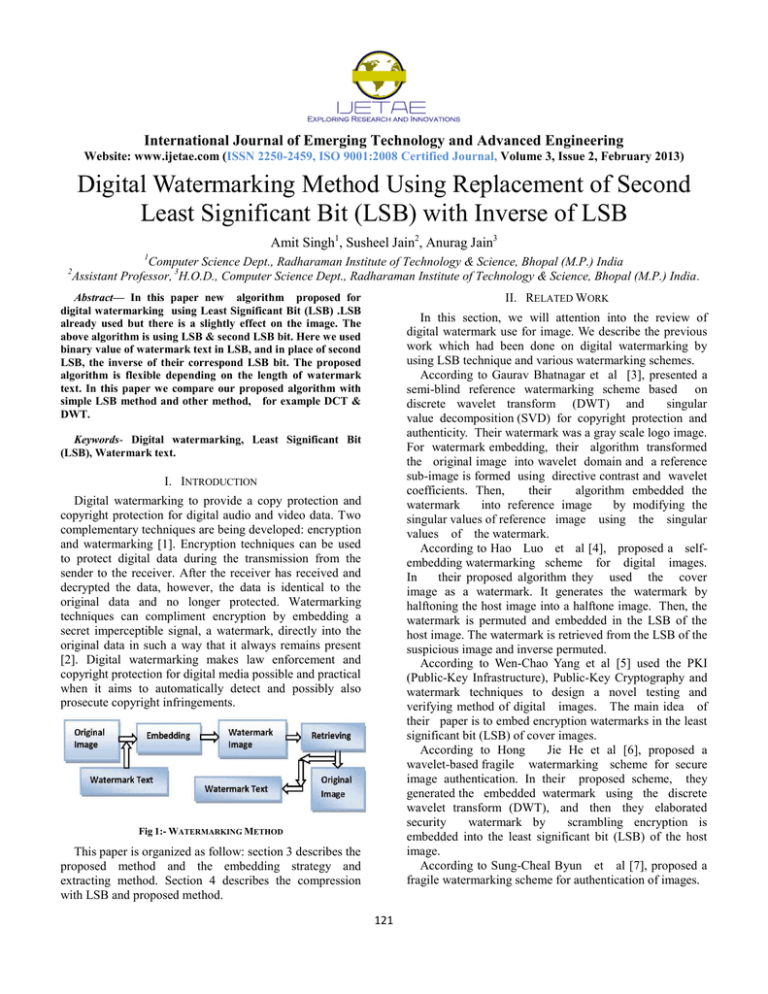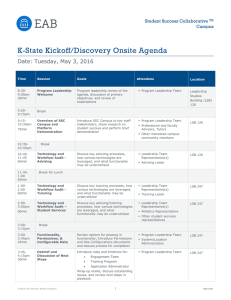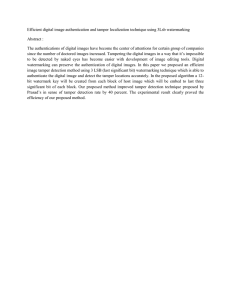
International Journal of Emerging Technology and Advanced Engineering
Website: www.ijetae.com (ISSN 2250-2459, ISO 9001:2008 Certified Journal, Volume 3, Issue 2, February 2013)
Digital Watermarking Method Using Replacement of Second
Least Significant Bit (LSB) with Inverse of LSB
Amit Singh1, Susheel Jain2, Anurag Jain3
1
Computer Science Dept., Radharaman Institute of Technology & Science, Bhopal (M.P.) India
Assistant Professor, 3H.O.D., Computer Science Dept., Radharaman Institute of Technology & Science, Bhopal (M.P.) India.
2
Abstract— In this paper new algorithm proposed for
digital watermarking using Least Significant Bit (LSB) .LSB
already used but there is a slightly effect on the image. The
above algorithm is using LSB & second LSB bit. Here we used
binary value of watermark text in LSB, and in place of second
LSB, the inverse of their correspond LSB bit. The proposed
algorithm is flexible depending on the length of watermark
text. In this paper we compare our proposed algorithm with
simple LSB method and other method, for example DCT &
DWT.
II. RELATED WORK
In this section, we will attention into the review of
digital watermark use for image. We describe the previous
work which had been done on digital watermarking by
using LSB technique and various watermarking schemes.
According to Gaurav Bhatnagar et al [3], presented a
semi-blind reference watermarking scheme based on
discrete wavelet transform (DWT) and
singular
value decomposition (SVD) for copyright protection and
authenticity. Their watermark was a gray scale logo image.
For watermark embedding, their algorithm transformed
the original image into wavelet domain and a reference
sub-image is formed using directive contrast and wavelet
coefficients. Then,
their
algorithm embedded the
watermark
into reference image
by modifying the
singular values of reference image using the singular
values of the watermark.
According to Hao Luo et al [4], proposed a selfembedding watermarking scheme for digital images.
In
their proposed algorithm they used the cover
image as a watermark. It generates the watermark by
halftoning the host image into a halftone image. Then, the
watermark is permuted and embedded in the LSB of the
host image. The watermark is retrieved from the LSB of the
suspicious image and inverse permuted.
According to Wen-Chao Yang et al [5] used the PKI
(Public-Key Infrastructure), Public-Key Cryptography and
watermark techniques to design a novel testing and
verifying method of digital images. The main idea of
their paper is to embed encryption watermarks in the least
significant bit (LSB) of cover images.
According to Hong
Jie He et al [6], proposed a
wavelet-based fragile watermarking scheme for secure
image authentication. In their proposed scheme, they
generated the embedded watermark using the discrete
wavelet transform (DWT), and then they elaborated
security
watermark by
scrambling encryption is
embedded into the least significant bit (LSB) of the host
image.
According to Sung-Cheal Byun et al [7], proposed a
fragile watermarking scheme for authentication of images.
Keywords- Digital watermarking, Least Significant Bit
(LSB), Watermark text.
I. INTRODUCTION
Digital watermarking to provide a copy protection and
copyright protection for digital audio and video data. Two
complementary techniques are being developed: encryption
and watermarking [1]. Encryption techniques can be used
to protect digital data during the transmission from the
sender to the receiver. After the receiver has received and
decrypted the data, however, the data is identical to the
original data and no longer protected. Watermarking
techniques can compliment encryption by embedding a
secret imperceptible signal, a watermark, directly into the
original data in such a way that it always remains present
[2]. Digital watermarking makes law enforcement and
copyright protection for digital media possible and practical
when it aims to automatically detect and possibly also
prosecute copyright infringements.
Fig 1:- WATERMARKING METHOD
This paper is organized as follow: section 3 describes the
proposed method and the embedding strategy and
extracting method. Section 4 describes the compression
with LSB and proposed method.
121
International Journal of Emerging Technology and Advanced Engineering
Website: www.ijetae.com (ISSN 2250-2459, ISO 9001:2008 Certified Journal, Volume 3, Issue 2, February 2013)
They used
singular values
of singular value
decomposition (SVD) of images to check the integrity of
images. In order to make authentication data, the
singular values are changed to the binary bits using
modular arithmetic. Then, they inserted the binary
bits into the least significant bits (LSBs) of the original
image. The pixels to be changed are randomly selected in
the original image.
According to Gil-Je Lee et al [8] presented a new LSB
digital watermarking scheme
by
using
random
mapping function. The idea
of their
proposed
algorithm
is embedding watermark randomly in the
coordinates of the image by using random function to be
more robust than the traditional LSB technique.
According to Saeid Fazli et al [9] presented trade-off
between imperceptibility and robustness of LSB
watermarking using SSIM Quality Metrics. In their
algorithm, they put significant bit-planes of the watermark
image instead of lower bit-planes of the asset picture.
According to Debjyoti Basu et al [10] proposed Bit
Plane Index Modulation (BPIM) based fragile
watermarking scheme for authenticating RGB color image.
By embedding R, G, B component of watermarking
image in the R, G, B component of original image,
embedding distortion is minimized by adopting least
significant
bit
(LSB) alteration scheme.
Their
proposed method consists of encoding and decoding
methods that can provide public detection capabilities in
the absences of original host image and watermark
image.
In the above technique the overcome drawback of
existing techniques, we introduce new method using LSB
and inverse of LSB.
Fig 2:- The Framework of the proposed method
A. Embedding Method
In this section, we describe the embedding method after
we select the image and convert into frame. The total
number of frame obtain by original image, we divide
watermark image with equal to number of frame. Sub part
of the watermark image, we inserted binary value in LSB
of original frame and change the second LSB bit according
to first LSB bit. If the first LSB bit is 1 then second LSB
will be 0 according to proposed method and if the first LSB
is 0 then second LSB will be inverse of first LSB that is 1.
Figure 3 shows the embedding algorithm.
III. PROPOSED WORK
Based on LSB techniques, we proposed a new
watermarking algorithm. Previous researchers have been
proposed the first LSB but our proposed watermarking
algorithm is first we insert watermark text binary bits in
Least Significant Bit (LSB) place and inverse of Least
Significant Bit (LSB), to insert second Least Significant Bit
(LSB). This is because of security region. After embedding
second Least Significant Bit (LSB) option without any
order. The figure 1 shows the frame work of the proposed
method. First we select the image which is a gray scale
image. If image is RGB color then we change image in to
gray scale by using HSV model. We will transfer the
watermark to binary value after typing it. Then, we embed
the watermark in the image using the proposed algorithm.
Figure 3 shows the embedding algorithm and figure 4
shows the extracting method.
B. Extracting Method
In this section, we will describe the extracting method
after receiving the watermark image. We will get the length
of watermark from first LSB bit we arrange the pixels
starting from the determined coordinate until we get it from
the last pixels. We can know how many copies the sender
has embedded. First of all we change second LSB
according to first LSB. If first LSB is 0 than second LSB
will be 0 and vice vase. Figure 4 shows the extracting
method.
122
International Journal of Emerging Technology and Advanced Engineering
Website: www.ijetae.com (ISSN 2250-2459, ISO 9001:2008 Certified Journal, Volume 3, Issue 2, February 2013)
IV. DISCUSSION
Input
1. Original image
2. Watermark text
Output
Watermark Image
Begin
1- Count the number of frame of original image.
2- Divide watermark text into number of frames.
3- Inserting sub part of watermark image into original
image one by one frame in LSB place.
4- Inverse the first LSB bit.
5- Check the coordinate of X, if it is odd, the
algorithm will add 1 to X, and if it is even, the
algorithm will subtract 1 from X.
6- Embed the watermark bit in the first LSB.
7- Go to 4 until finishing all the watermark.
8- Go to 4 if we need to embed another copy of the
watermark text.
9- Save the Image as bitmap image
End
Message: 0 1 1 0 0 1 0 1 0 1 1 1 0 1 0 1 0 1 0 0 0
Randomly chosen pixel with color
Find the color
C1
C1 in the sorted palette
00011110 = index = 30
00011111 = index = 31
Fig 3:- Embedding Method
00011101 = index = 29
C2
Input:
Watermarked Image.
Output:
Watermark text.
Begin:
1- 1-Get the length of the watermark text from the
first LSB.
2- Count the LSB which is used number of copy by
user.
3- Check the coordinate of X, if it is odd, the
algorithm will add 1 to X, and if it is even, the
algorithm will subtract 1 from X.
4- Get the bit from the first LSB.
5- Converse the bit and save it in array.
6- Go to 3 until finishing all the watermark text.
7- Convert the array to characters.
End
Replace the LSB of the index to color C1 with the
message bit. The new index now points to a neighboring
color C2. Replace the index of the pixel in the original
image to point to the new color C2 and the index value of
C2 is 29.
V. COMPRESSION WITH LSB AND PROPOSED METHOD
By discussing we observed that In LSB method we
obtained an index number 31 which is neighboring color of
index number 30, but by proposed method we obtained
index number 29 which is also neighboring color 30. So the
given proposed method is better with LSB method because
it is better authenticity due to using of second Least
Significant Bit.
VI. CONCLUSION
Digital watermarking using LSB and inverse of LSB are
most powerful method for proposed work. In this article
put the image authentication and copy right protection. It is
better with simple LSB method.
Fig 4:- Extracting Method
123
International Journal of Emerging Technology and Advanced Engineering
Website: www.ijetae.com (ISSN 2250-2459, ISO 9001:2008 Certified Journal, Volume 3, Issue 2, February 2013)
REFERENCES
ABOUT AUTHORS
[1 ] Mandhani, N. K. (2004), “Watermarking Using Decimal
Sequences”, Master thesis submitted to the Graduate Faculty of the
Louisiana State University, India
[2 ] Serrão, C. and Guimarães, J. (1999), Protecting Intellectual
Proprietary Rights through Secure Interactive Contract Negotiation,
Springer-Verlag Berlin Heidelberg 1999.
[3 ] Bhatnagar, G. and Raman, B. (2008), A new robust reference
watermarking scheme based on DWT-SVD, Elsevier B.V. All rights
reserved.
[4 ] Luo, H, Chu, S. H. and Lu, Z. M. (2008), Self Embedding
Watermarking Using Halftoning Technique, Circuits Syst Signal
Process (2008) 27: 155–170
[5 ] Yang, W. C., Wen, C. Y. and Chen, C. H., (2008), Applying PublicKey Watermarking Techniques in Forensic Imaging to Preserve the
Authenticity of the Evidence. Springer-Verlag Berlin Heidelberg
2008.
[6 ] He, H. J., Zhang, J. S. and Tai, H. M., (2006), A Wavelet-Based
Fragile Watermarking Scheme for SecureImage Authentication.
Springer-Verlag Berlin Heidelberg 2006
[7 ] Byun, S. C., Lee, S. K., Tewfik, A. H. and Ahn, B. H., (2003), A
SVD-Based
Fragile Watermarking
Scheme
for
Image
Authentication. Springer-Verlag Berlin Heidelberg 2003
[8 ] Lee, G. J., Yoon, E. J. and Yoo, K. Y. (2008), “A new LSB based
Digital Watermarking Scheme with Random Mapping Function”, in
2008 IEEE DOI 10.1109/UMC.2008.33
[9 ] Fazli, S.and Khodaverdi, G (2009), Trade-off between
Imperceptibility and Robustness of LSB Watermarking using SSIM
Quality Metrics, in 2010 IEEE DOI 10.1109/ICMV.2009.68
[10 ] Basu, D., Sinharay, A. and Barat, S., (2010), Bit Plane Index Based
Fragile Watermarking Scheme for Authenticating Color Image.
IEEE, DOI 10.1109/ICIIC.2010.53.
Amit Singh, is a scholar of M.Tech, (Computer Science
Engineering), at R.I.T.S. Bhopal, under R.G.T.U. Bhopal,
M.P., India.
Susheel Jain, Assistant Professor in Computer science
department of R.I.T.S., Bhopal, M.P. He has done his
M.Tech. in Software Engineering From Gautam Buddh
Technical University, Lucknow, India.
Anurag Jain, H.O.D. of Computer science department of
R.I.T.S. Bhopal, M.P. He has done his M.Tech, in
Computer Science and Engineering, From Barkatullah
University, Bhopal, India.
124






